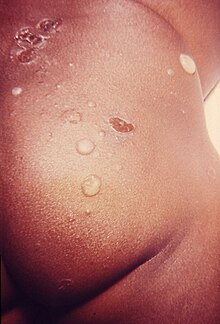Staphyloderma
| Classification according to ICD-10 | |
|---|---|
| L08.0 | Pyoderma |
| ICD-10 online (WHO version 2019) | |
In medicine, staphyloderma is generally understood to be an infectious skin disease that is caused by a specific group of pus bacteria, the staphylococci . Different forms are differentiated according to the course and symptoms. Treatment is possible either with topical antiseptic ointments or antibiotics , depending on the severity .
Classification and symptoms
Follicular staphyloderma
Synonyms are Staphylodermia follicularis, Ostiofolliculitis (Bockhart), Impetigo Bockhart, Impetigo follicularis Bockhart, Folliculitis staphylogenes superficialis, Folliculitis pustulosa, Bockhart impetigo . In this form, the openings of the hair follicles are superficially inflamed by the pus pathogen Staphylococcus aureus . Yellowish pustules with a red halo often appear around the hair follicles. Preferred body regions are the face, the hairy scalp and the extremities.
Staphylodermia superficialis diffusa exfoliativa
Synonyms are staphylococcal scalded skin syndrome (syndrome of scalded skin), staphylogenic Lyell syndrome , Ritter von Rittershain's disease (after Gottfried Ritter von Rittershain ).
It is a toxicosis of the skin caused by the remote action of specific toxins of Staphylococcus aureus of phage group II with phage type 71. These bacteria produce the toxin exfoliate , which is released into the bloodstream and leads to the formation of cracks in the upper skin ( epidermis ). As a result, superficial skin blisters form, which easily burst, which leads to the detachment of larger skin flaps with corresponding wound surfaces. This form occurs predominantly in children under five years of age.
Impetigo contagiosa staphylogenes (large bladder impetigo)
This clinical picture is caused by Staphylococcus aureus of phage group II. Flaccid blisters form that are filled with a clear to yellowish-purulent liquid. As soon as these burst open, they dry up into honey-yellow crusts. There is a very high risk of infection until all lesions have healed. In addition to the large-bubble impetigo caused by staphylococci, there is also a small-bubble form, this is less common and is caused by streptococci . For more information, see Impetigo contagiosa .
therapy
In the case of the follicular form, local antiseptic treatment with bacteria- killing solutions, possibly also with fusidic acid ointments, may be sufficient. If necessary, the pustules can also be opened and the affected areas of skin then treated with moist compresses with antiseptic solutions. If this is not enough, antibiotics may also have to be given internally as juice, tablets or infusion . Exfoliative staphyloderma is always a serious illness that requires antibiotic therapy as an infusion and supportive intensive care. With impetigo contagiosa, strict hygienic measures including covering the highly contagious skin lesions are also required.
literature
- P. Altmeyer, M. Bacharach-Buhles: Springer Encyclopedia Dermatology, Allergology, Environmental Medicine. Springer, 2002, ISBN 3-540-41361-8 .
Web links
Individual evidence
- ↑ Alphabetical directory for the ICD-10-WHO version 2019, volume 3. German Institute for Medical Documentation and Information (DIMDI), Cologne, 2019, p. 821

